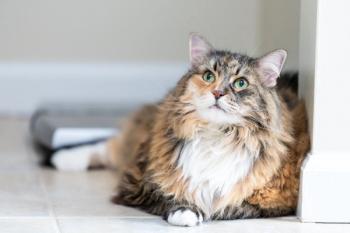
- dvm360 May 2021
- Volume 55
Anesthesia for the geriatric patient
Because the risk for anesthesia-associated complications increases in patients with advanced age, a thorough preanesthetic assessment and patient stabilization and monitoring are required for the best outcomes.
Advances in veterinary medicine have improved longevity in companion animals,1 and the geriatric anesthesia caseload is increasing. A patient may be considered geriatric when it has completed 75% to 80% of its expected life span, which varies by species and breed.2 A large number of geriatric patients present with comorbidities that must be considered during anesthetic planning, but many have no known systemic disease. Nevertheless, even “healthy” geriatric patients have a decreased functional capacity to respond to stress that does not become apparent until anesthesia and surgery. To avoid unexpected poor outcomes, anesthesia for all geriatric patients must be approached with special consideration of their altered physiologic responses to drugs and stress.
Physiology
Cardiovascular system
Geriatric patients have decreased cardiovascular reserve and diminished compensatory mechanisms compared with adult animals. In adults, hypotension triggers a baroreceptor reflex that increases heart rate and contractility, whereas in geriatric animals this reflex is reduced.2,3 These patients are more reliant on adequate plasma volume for blood pressure maintenance, but renal free water excretion is less efficient, and the geriatric heart and lungs are more susceptible to congestive heart failure and pulmonary edema. Geriatric patients have decreased blood pressure under normal conditions, resulting in a higher resting heart rate and longer circulation time.2,4,5 The latter causes a longer onset of effect for injectable drugs, which may lead to premature repeated and excessive drug administration. As the cardiac conduction system ages, it becomes more susceptible to arrhythmias, especially when the aging cardiopulmonary system fails to meet the increased myocardial oxygen demands associated with pain and stress.
Respiratory system
The aging lungs have decreased functional residual capacity—the reserve volume available for gas exchange during apnea—and thus faster onset of hypoxemia. Decreased chest wall compliance means the work of breathing is increased, while the aging muscles fatigue more quickly. These changes increase the risk of hypoventilation during anesthesia. Hypercapnia causes acidosis and decreased cardiac contractility, which negatively affect blood pressure. Sometimes the patient will mount a sympathetic response to the hypercapnia, but this can be equally detrimental, with tachycardia increasing myocardial oxygen demand and vasoconstriction reducing renal and hepatic blood flow.
Renal and hepatic systems
Many geriatric animals have reduced renal mass, renal filtration, and excretion.2 Similarly, they have reduced hepatic mass, which leads to a decrease in total hepatic enzymatic function and blood flow, causing delayed drug clearance. Vasoconstriction that can occur in response to stress or pain reduces renal and hepatic blood flow, compromising renal perfusion and further reducing metabolic function. Of course, any disease of the kidneys and/or liver will further alter drug metabolism and clearance, exacerbate the hemodynamic consequences of anesthesia, and predispose the patient to acute kidney injury.
Neurologic system
Geriatric patients require lower doses of anesthetic drugs to produce the same clinical effect.4 This phenomenon, combined with delayed onset due to longer circulation time, places these patients at a higher risk for overdose from repeated drug administration, resulting in excessive anesthetic depth and prolonged recoveries.
Visual and hearing impairment, as well as cognitive dysfunction, are common in aging pets (Figure 1). These conditions predispose patients to confusion and stress during hospitalization, which is exacerbated by restraint. The sympathetic response to stress can be detrimental in these patients, as their vital organs lack the functional reserve to compensate for stress-related tachycardia, vasoconstriction, and increased oxygen demand.
Body composition
Some geriatric patients have excess fat and an increased volume of distribution for most anesthetic drugs. This prolongs the duration of action but does not warrant an increased dose, as geriatric patients usually require a lower dose for a given clinical effect. Geriatric patients may alternately present with very little fat, which, in conjunction with reduced muscle mass, increases their risk for hypothermia (Figure 2). Hypothermia impairs cardiovascular function, reduces anesthetic drug requirements, prolongs recovery, and causes discomfort and shivering. Shivering exacerbates pain, stimulates catecholamine release, and increases oxygen demand.6
Between the decreased muscle mass and higher incidence of osteoarthritis, geriatric patients should be transported and positioned with care. Adequate padding of dependent areas and reducing stress on joints and ligaments are essential. When considering analgesic drugs, the pain associated with positioning should be considered in addition to the procedure itself.
Anesthetic management
Preanesthetic assessment
The practitioner should complete a thorough history, including a review of comorbidities and medications. Diagnostic tests should be performed and reviewed ahead of time to screen for new comorbidities or determine the extent of known disease. These should include blood work (especially packed cell volume/total solids, liver enzymes, blood urea nitrogen, creatinine, symmetric dimethylarginine, electrolytes, thyroid panel, and clotting profile if indicated), urinalysis, and diagnostic imaging (chest x-rays, with or without abdominal ultrasound if indicated by abnormalities on physical exam or blood work). Abnormalities should be corrected prior to anesthesia when possible; otherwise, referral to a specialty practice for further workup and preanesthetic optimization should be considered.
Most medications should be continued, with few exceptions. Angiotensin-converting enzyme (ACE) inhibitors (benazepril, enalapril) should be withheld the morning of anesthesia to reduce the incidence of refractory hypotension7; telmisartan, an angiotensin receptor blocker used increasingly for the treatment of protein-losing nephropathy, acts on the same pathway, and withholding this drug may be prudent. The antithrombotic medication clopidogrel should be discontinued 10 days prior to surgery but can be continued for nonsurgical procedures. Patients receiving prednisone for hypoadrenocorticism should receive an increased dose (ie, double their normal morning dose) to help them tolerate the stress associated with anesthesia and surgery.
Some medications can also alter the effects of sedative and anesthetic drugs. For example, phenobarbital induces hepatic enzymes and can hasten drug clearance, but the clinical effect of sedative and anesthetic drugs may be more pronounced. Patients receiving medications that affect vasomotor tone (ACE inhibitors, calcium channel blockers, pimobendan) are at a higher risk for hypotension from vasodilating agents, especially acepromazine and inhalant agents. A drug reference should be consulted for a list of potential drug interactions.
Premedication
Premedication is the use of sedative and analgesic agents prior to the induction of anesthesia. This practice reduces stress associated with restraint and anesthesia, facilitates intravenous catheter placement, reduces the doses of anesthetic drugs required, provides preemptive analgesia, and improves the quality of recovery. Combination protocols capitalize on drug synergism, allowing a reduced dose of each drug. Onset and clinical effect can be unpredictable in geriatric patients, and the practitioner should be prepared to provide supplemental oxygen using a face mask upon onset of sedation.
The combination of an opioid appropriate for the level of pain anticipated and a benzodiazepine offers analgesia and mild sedation in geriatric patients with minimal cardiorespiratory effects. In very anxious or fearful patients for whom a benzodiazepine will offer inadequate sedation, a low dose of acepromazine (0.01-0.03 mg/kg) can be considered, weighing the benefits of superior sedation with the risk for hypotension.
Alpha-2 agonists (eg, dexmedetomidine) decrease cardiac output,8 which is not desirable given the age-related changes in cardiovascular function and cardiac reserve. However, these drugs also reduce sympathetic tone and the detrimental effects associated with increased circulating catecholamines. Use of a conservative dose (0.5-2 mcg/kg) in combination with an opioid and benzodiazepine may be useful in the stressed geriatric patient.
Ketamine at a moderate intramuscular dose of 1 to 2 mg/kg in dogs or 2 to 3 mg/kg in cats is a safe and effective alternative to dexmedetomidine when an opioid/benzodiazepine combination will not provide adequate sedation. Ketamine at moderate to high doses should be avoided in patients with pre-existing tachycardia, hypertension, or hypertrophic cardiomyopathy due to the potential for sympathetic stimulation and increased myocardial oxygen demand.
Alfaxalone can also be used for intramuscular sedation in geriatric cats and dogs at doses of 1 to 3 mg/kg, in combination with an opioid and benzodiazepine. This is especially useful in fearful geriatric cats for whom ketamine is contraindicated due to the presence of cardiac disease. The high volume required makes this most practical for small patients and may warrant 2 injections to reduce muscle trauma. The level of sedation is unpredictable, and the patient may require supplemental oxygen or even intubation depending on the effect.
Induction
Induction of anesthesia should be achieved with injectable agents. Mask and chamber inductions may cause a life-threatening stress response, and the dose of inhalant required to induce anesthesia causes significant cardiovascular depression. Furthermore, these techniques expose personnel to high levels of waste anesthetic gases.
Propofol is commonly used in geriatric patients because it can be titrated slowly to effect and the duration is short due to rapid redistribution. Propofol is also the drug of choice for patients with reduced liver function, because metabolism is largely extrahepatic. However, propofol can cause significant cardiovascular (bradycardia, vasodilation, decreased contractility, hypotension) and respiratory (hypoventilation, apnea) derangements. The total dose needed can be reduced by titrating at a rate of 1 mg/kg/min,9 and by using a co-induction agent such as ketamine and/or a benzodiazepine.
Alfaxalone has a similar effect profile to propofol, but with better maintenance of cardiac output owing to preservation of the baroreceptor reflex,10,11 although the extent to which this is true in geriatric patients remains to be elucidated. Alfaxalone should be titrated at a rate of 0.5 mg/kg/min9 and may be combined with ketamine and/or a benzodiazepine.
Because etomidate has minimal cardiorespiratory effects, it is ideal for patients with significant cardiac or respiratory disease. Adverse effects include pain on injection, gagging, and hemolysis. Co-induction with midazolam and administration with intravenous fluids running can mitigate these effects. In dogs, I have found that intravenous lidocaine administered just before etomidate seems to reduce pain on injection.
Ketamine at doses required for anesthesia induction (2-6 mg/kg intravenously) causes tachycardia and increased myocardial oxygen demand, and thus is not ideal as a primary induction agent in geriatric patients with decreased cardiac reserve. However, it can be considered for use as a co-induction agent at lower doses.
Maintenance
General anesthesia can be maintained with a variety of drugs and drug combinations. Regardless of drug choice, anesthetized patients should be intubated and receive oxygen supplementation, with ventilatory support as needed. An experienced veterinary nurse or doctor should monitor the patient using pulse oximetry, capnography, electrocardiography, blood pressure and temperature measurement, and hands-on assessment of anesthetic depth (palpebral, jaw tone), mucous membrane color and refill time, and pulse quality.
Inhalant anesthetics (eg, isoflurane, sevoflurane) cause vasodilation, decreased cardiac contractility, and respiratory depression. Geriatric patients are particularly susceptible to the resulting hypotension, hypoventilation, and hypoxemia. Therefore, use of a multimodal anesthetic protocol to reduce inhalant anesthetic requirements is recommended. A ketamine continuous-rate infusion (CRI) can be administered during anesthesia to provide analgesia and reduce anesthetic requirements without causing sympathetic stimulation. Adding 120 mg ketamine to 1 L of fluids and administering at a rate of 5 mL/kg/hour will provide a ketamine infusion of 10 mcg/kg/min. Other CRIs I use commonly to reduce anesthetic requirements include fentanyl (5-20 mcg/kg/hour) and lidocaine (25-75 mcg/kg/min).
Local blocks are effective for reducing anesthetic requirements, improving patient comfort in the postoperative period, and reducing systemic opioid use (Figure 3). Local anesthetics are the only drugs that completely block nociceptive transmission, and I consider locoregional anesthesia to be an essential component of a multimodal approach to anesthesia and analgesia.
For critical or sick geriatric patients, inhalant anesthetics may not be well tolerated, and a total intravenous anesthesia technique should be considered. A propofol CRI (0.1-0.4 mg/kg/min) can be used but tends to have similar cardiovascular and respiratory effects to inhalant anesthetics. Alfaxalone at a rate of 0.05 to 0.2 mg/kg/min appears to have a more favorable cardiovascular effect profile. Use of other concurrent CRIs (fentanyl, ketamine, and/or lidocaine) can reduce the requirement for propofol or alfaxalone.
During anesthesia, many geriatric patients require additional cardiovascular support. Judicious use of fluid therapy is recommended, and fluid boluses should be reserved for patients with evidence of hypovolemia. Anticholinergics are often indicated to maintain heart rate in the normal range to optimize cardiac output and blood pressure. Ephedrine, dopamine, or dobutamine may be indicated for refractory hypotension, with the optimal choice depending on species and concurrent disease. Keep in mind that hypothermia may cause bradycardia and hypotension that are refractory to pharmacologic intervention.
Recovery
About half of all anesthesia-related deaths in dogs and cats occur during recovery, mostly during the first 3 hours.12 Compared with adults, geriatric animals are especially predisposed to prolonged recoveries due to slower drug clearance, more profound responses to anesthetic drugs, and increased incidence of hypothermia, hypotension, and hypoxemia. Pulse oximetry, respiration, heart rate, blood pressure, and temperature should be monitored at regular intervals until these vitals return to within normal limits or near baseline (Figure 4). Patients with visual or hearing impairment or cognitive dysfunction may become confused and agitated during recovery, and may require additional time to recover. In elderly humans, full return of cognitive function to preoperative levels after general anesthesia may require up to 2 weeks.3 In older laboratory animals given general anesthesia, impairment of learning persists long after the effects of anesthetic agents have dissipated.3
Conclusion
Geriatric dogs and cats are at an increased risk for anesthesia-associated complications because of the normal physiologic changes that occur with aging. They are also more likely to present with concurrent diseases. Anesthesia for these patients should be performed only after a thorough preanesthetic assessment and patient stabilization. Reduction of stress and pain in the perianesthetic period is essential to avoid excessive sympathetic stimulation. While no specific drug protocol has been shown to decrease morbidity or mortality in geriatric patients, the practitioner should use a multimodal approach and tailor anesthetic protocols to each individual patient, taking into account aging changes and comorbidities. Patients should be monitored closely from premedication to full recovery from anesthesia, and the practitioner should be prepared to provide ventilatory and cardiovascular support beyond that which most healthy adult animals require. Advanced age is neither a disease nor a contraindication to anesthesia but demands special care and attention from the practitioner to promote the best outcomes for these patients.
References
- Egenvall A, Nødtvedt A, Häggström J, Ström-Holst B, Möller L, Bonnett BN. Mortality of life-insured Swedish cats during 1999-2006: age, breed, sex, and diagnostics. J Vet Intern Med. 2009;23(6):1175-1183. doi:10.1111/j.1939-1676.2009.0396.x
- Hughes JML. Anaesthesia for the geriatric dog and cat. Ir Vet J. 2008;61(6):380-387. doi:10.1186/2046-0481-61-6-380
- Muravchick S. Anesthesia for the geriatric patient. In: Barash PG, Cullen BF, Stoelting RK (eds). Clinical Anesthesia, 5th ed. Lippincott-Raven; 2005:531-540.
- Kukanich B. Geriatric veterinary pharmacology. Vet Clin North Am Small Anim Pract. 2012;42(4):631-642. doi:10.1016/j.cvsm.2012.04.007
- Meurs KM, Miller MW, Slater MR, Glaze K. Arterial blood pressure measurement in a population of healthy geriatric dogs. J Am Anim Hosp Assoc. 2000;36(6):497-500. doi:10.5326/15473317-36-6-497
- Diaz M, Becker DE. Thermoregulation: physiological and clinical considerations during sedation and general anesthesia. Anesth Prog. 2010;57(1):25-33. doi:
10.2344/0003-3006-57.1.25 - Coleman AE, Shepard MK, Schmiedt CW, Hofmeister EH, Brown SA. Effects of orally administered enalapril on blood pressure and hemodynamic response to vasopressors during isoflurane anesthesia in healthy dogs. Vet Anaesth Analg. 2016;43(5)482-494. doi:10.1111/vaa.12338
- Murrell JC, Hellebrekers LJ. Medetomidine and dexmedetomidine: a review of cardiovascular effects and antinociceptive properties in the dog. Vet Anaesth Analg. 2005;32(3):117-127. doi:10.1111/j.1467-2995.2005.00233.x
- Bigby SE, Beths T, Bauquier S, Carter J. Effect of rate of administration of propofol or alfaxalone on induction dose requirements and occurrence of apnea in dogs. 2017;44(6):1267-1275. doi:10.1016/j.vaa.2017.03.005
- Hampton CE, Riebold TW, LeBlanc NL, Scollan KF, Mandsager RE, Sisson DD. Effects of intravenous administration of tiletamine-zolazepam, alfaxalone, ketamine-diazepam, and propofol for induction of anesthesia on cardiorespiratory and metabolic variables in healthy dogs before and during anesthesia maintained with isoflurane. Am J Vet Res. 2019;80(1):33-44. doi:10.2460/ajvr.80.1.33
- Muir W, Lerche P, Wiese A, Nelson L, Pasloske K, Whittem T. Cardiorespiratory and anesthetic effects of clinical and supraclinical doses of alfaxalone in dogs. Vet Anaesth Analg. 2008;35(6):451-462. doi:10.1111/j.1467-2995.2008.00406.x
- Brodbelt DC, Blissit KJ, Hammond RA, et al. The risk of death: the confidential enquiry into perioperative small animal fatalities. Vet Anaesth Analg. 2008;35(5):365-373. doi:10.1111/j.1467-2995.2008.00397.x
Molly Allen, DVM, DACVAA, is an anesthesiologist at BluePearl Specialty + Emergency Pet Hospital in Waltham, Massachusetts. Her special interests include anesthesia training, patient safety, advanced locoregional techniques, and strategies for promoting enhanced recovery from anesthesia in small animal patients.
Articles in this issue
over 4 years ago
Respiratory disease: Pair up for protectionover 4 years ago
PIMS for corporate practicesover 4 years ago
Reader feedback: The nuances of veterinary practice valuationover 4 years ago
Why so much whiteness in the veterinary profession?over 4 years ago
May is Mental Health Month: Let the healing beginover 4 years ago
A closer look at veterinary unionsover 4 years ago
From new grad to veterinary practice ownerover 4 years ago
Tips for managing diabetes in dogs and catsover 4 years ago
Setting, monitoring, and achieving KPIs in veterinary practiceover 4 years ago
Upping your lateral suture gameNewsletter
From exam room tips to practice management insights, get trusted veterinary news delivered straight to your inbox—subscribe to dvm360.






